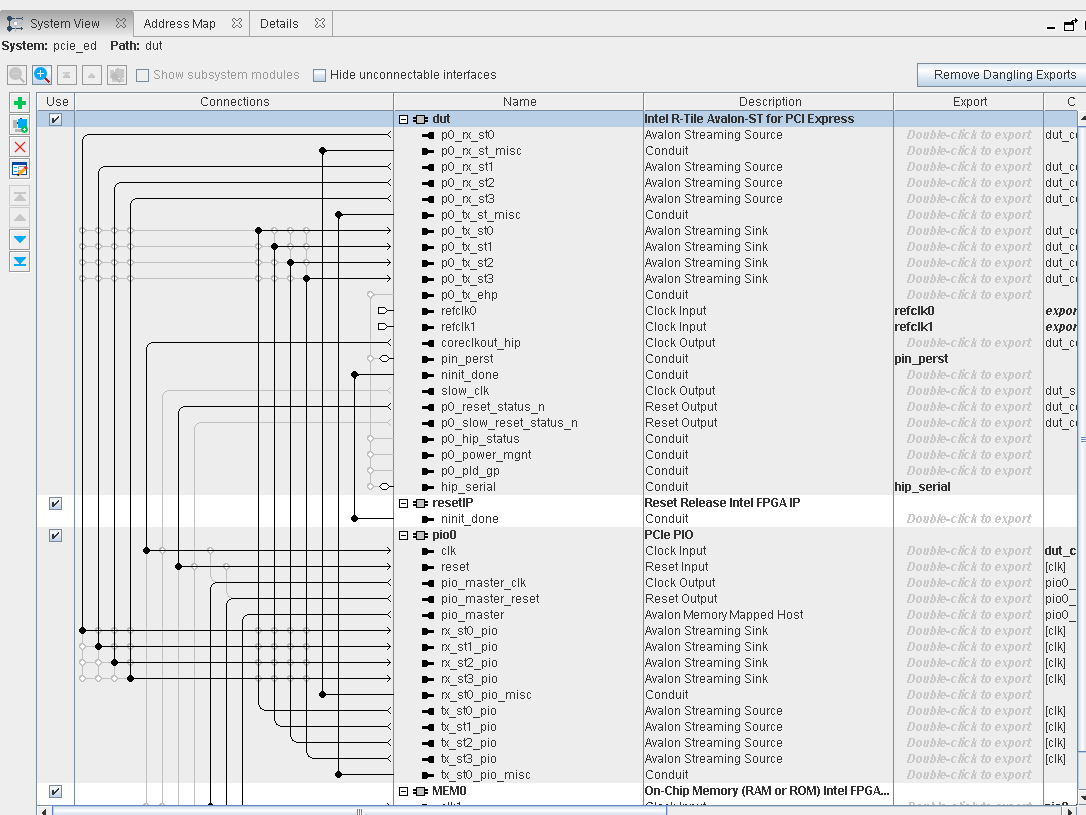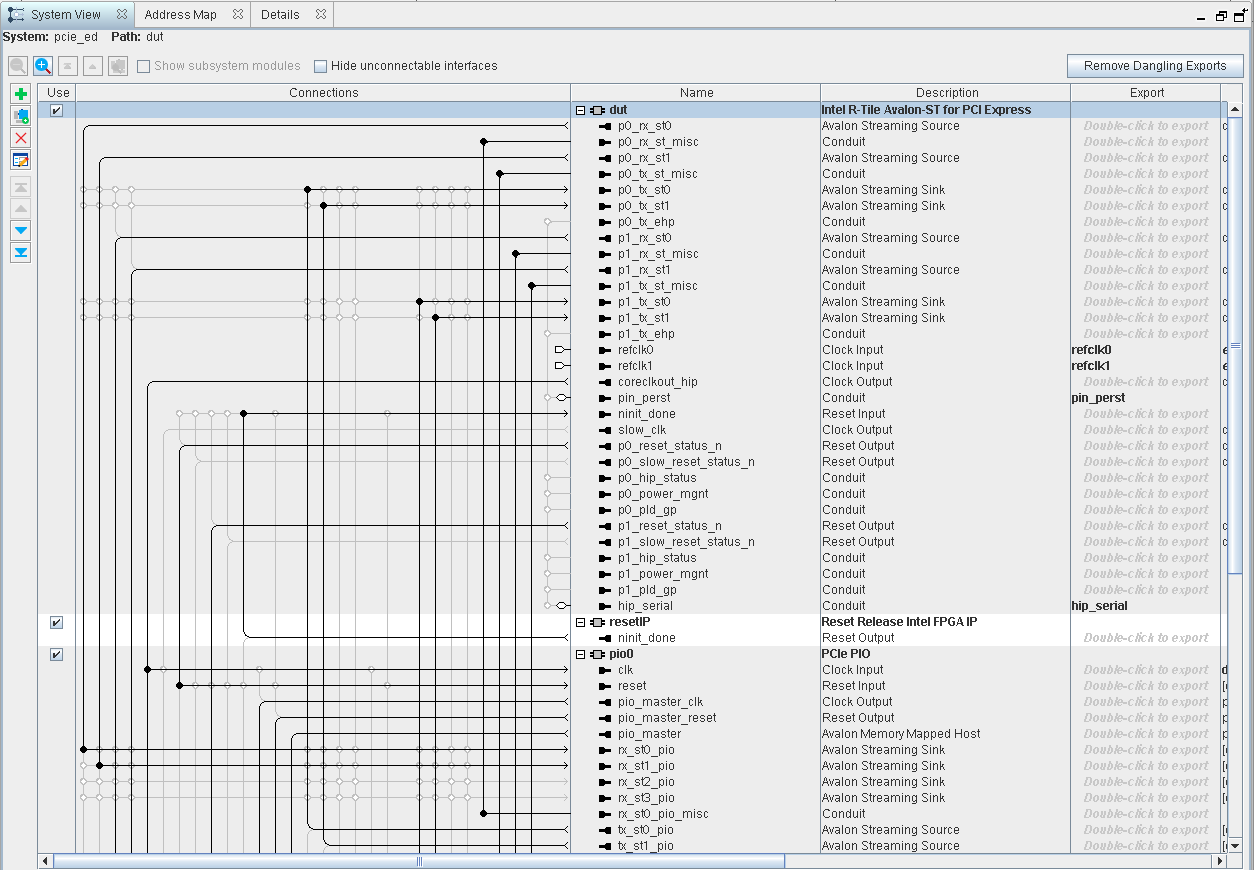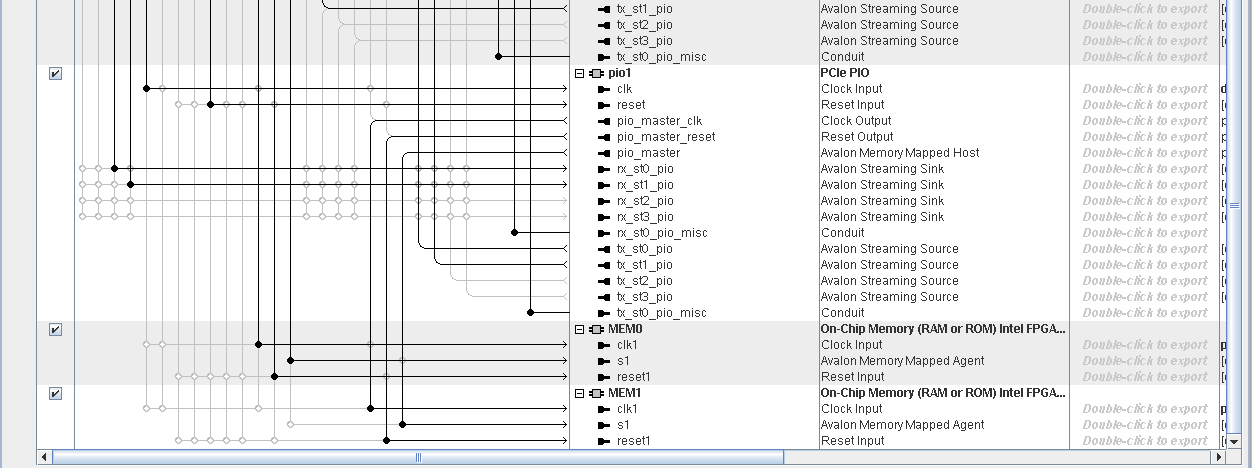Visible to Intel only — GUID: cpt1659743649293
Ixiasoft
Visible to Intel only — GUID: cpt1659743649293
Ixiasoft
1.2.1. Functional Description for the Programmed Input/Output (PIO) Design Example
The Programmed Input/Output (PIO) design example performs memory transfers from a host processor to a target device. In this design example, the host processor performs Memory Read (MemRd) and Memory Write (MemWr) Transaction Layer Packets (TLPs). Note that this design example does not support back-to-back transactions from the host processor since the design is intended to showcase single-dword transactions.
The PIO design example automatically creates the files necessary to simulate and compile in the Quartus® Prime software. The design example covers a wide range of parameters. However, it does not cover all possible parameterizations of the R-Tile Hard IP for PCIe.
This design example supports the following configurations:
| Port Mode | Link Width | Link Speed | Data Width (Bits) | Design Example Support | Simulators Supported |
|---|---|---|---|---|---|
| Endpoint | x16 | Gen5 | 1024 (4 x 256) | SCTH | Siemens EDA QuestaSim* , QuestaFE, VCS* , VCS* MX, Xcelium* 3 |
| Gen4 | 1024 (4 x 256) | CTH | N/A | ||
| 512 (2 x 256) | N/A | N/A | |||
| Gen3 | 1024 (4 x 256) | CTH | N/A | ||
| 512 (2 x 256) | N/A | N/A | |||
| x8 | Gen5 | 512 (2 x 256) | SCTH | Siemens EDA QuestaSim* , VCS* , VCS* MX, Xcelium* 3 | |
| Gen4 | 512 (2 x 256) | CTH | N/A | ||
| 256 (1 x 256) | N/A | N/A | |||
| Gen3 | 512 (2 x 256) | CTH | N/A | ||
| 256 (1 x 256) | N/A | N/A | |||
| x4 | Gen5 | 256 (2 x 128) | N/A | N/A | |
| Gen4 | 256 (2 x 128) | N/A | N/A | ||
| 128 (1 x 128) | N/A | N/A | |||
| Gen3 | 256 (2 x 128) | N/A | N/A | ||
| 128 (1 x 128) | N/A | N/A | |||
| Root Port | N/A | N/A | N/A | N/A | N/A |
| TL Bypass | N/A | N/A | N/A | N/A | N/A |
| PIPE Direct (PIPE-D) |
N/A | N/A | N/A | N/A | N/A |
- The generated R-Tile Avalon® Streaming (Avalon-ST) Hard IP Endpoint variant (DUT) with the parameters you specified. This component drives TLP data received to the PIO application. It translates the PCIe serial data received from the link to the Avalon® -ST data format.
- The PIO Application (APPS) component, which performs the necessary translation between the PCI Express TLPs and simple Avalon® Memory-mapped ( Avalon® -MM) writes and reads to the on-chip memory.
Note: The current APPS component supports only single-cycle data transfers. Data transfers longer than one clock cycle are not supported.
- An on-chip memory (MEM) component (one 32 KB memory for the x16 design example, and two 32 KB memories for the 2x8 design example).
- Reset Release IP: This IP holds the control circuit in reset until the device has fully entered user mode. The FPGA asserts the nINIT_DONE output to signal that the device is in user mode. The nINIT_DONE signal is high until the entire device enters user mode. After nINIT_DONE deasserts (low), all logic is in user mode and operates normally.
The Gen5 x16 design example instantiates a PIO component with a 1024-bit data path to interface with the 1024-bit DUT. The clock comes from the coreclkout_hip output of the IP and runs at 500 MHz. Also, the design example instantiates only one MEM device as shown in the figure below.
The Gen5 2x8 design example instantiates two PIO components with 512-bit data paths to interface with the 2x512-bit DUT. The clock comes from the coreclkout_hip output of the IP and runs at 500 MHz. Also, the design example instantiates two MEM devices as shown in the figure below.
For simulation purposes, this design example also generates a testbench that instantiates the PIO design example and a Root Port BFM to interface with the target Endpoint.
The test program writes to and reads back data from the same location in the on-chip memory. It compares the data read to the expected result. The test reports, "Simulation stopped due to successful completion" if no errors occur.


